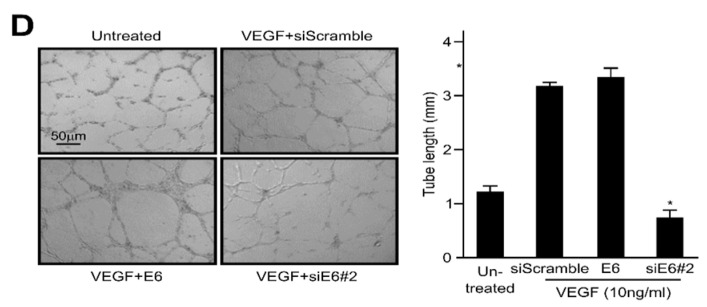Figure 2.
HPV16 E6 facilitates vascular endothelial growth factor (VEGF)-induced endothelial cell migration, proliferation and tubular network formation in vitro. (A,B) Boyden chamber-based migration assays were conducted to determine whether the transfected HPV16 E6 regulates the effects of VEGF on endothelial cell migration. After treatment with VEGF, HUVECs were transfected with siScramble, HPV16 E6 or HPV16 E6-siRNA (siE6#2) (A), or siE6#2 constructs at various concentrations (B). Human umbilical vein endothelial cells (HUVECs) were added to the top chamber of the Boyden Transwell chamber (pore size, 8 μm), fixed, and then stained with Haematoxylin and Eosin (H&E). The number of migrated cells was evaluated under a light microscope. Three independent experiments were conducted in triplicate; * p < 0.05 compared with siScramble. (C) Effects of HPV16 E6 on endothelial cell proliferation. HUVECs were grown and incubated for 3 days with or without VEGF. The c.p.m. of [3H]thymidine was calculated using a liquid scintillation counter. Each data point represents triplicate samples, and the bars indicate the mean ± SD; * p < 0.05 versus siScramble. All experiments were performed at least three times with consistent and similar results. (D) HUVECs were transfected with siScramble, HPV16 E6 or HPV16 E6-siRNA (siE6#2) and then grown on growth factor-reduced Matrigel in the presence or absence of 10 ng/mL VEGF. The capillary-like tubular network formation was monitored under an inverted microscope; scale bars represent 50 μm. The tube lengths were quantified and expressed as mean ± SD; * p < 0.05 versus siScramble. Each data bar represents the mean ± SD of three independent experiments that yielded similar values.


